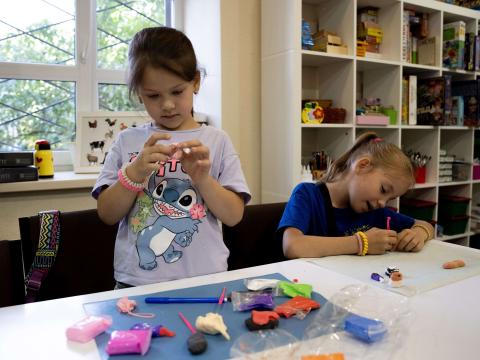As war rages on, Ukraine’s children struggle for safe access to education

As the war in Ukraine grinds on, ensuring children’s safety at school has become a growing challenge. Security threats and widespread damage to infrastructure have shuttered thousands of schools, disrupting education and leaving many children behind, especially the youngest.
One in five children aged 3 to 5 no longer has access to preschool education, according to Ukraine’s Ministry of Education and Science. The situation is even more critical for internally displaced families and those living near the frontlines, where absenteeism spikes to 30% and 37% respectively.
The scale of destruction is staggering: nearly 400 educational facilities have been destroyed, with thousands more damaged. Each attack not only disrupts learning but also deepens psychological trauma, underlining the urgent need for safe, accessible, and inclusive education.
“We’re not just providing education; we’re helping children stay resilient and hopeful for the future.”
Recognising this, World Vision’s Ukraine Crisis Response (WV UCR), in partnership with Save Ukraine and with funding from the European Union, launched the project “Safe Access to Equitable and Inclusive Education in Ukraine.” The initiative supports vulnerable children, including those with disabilities, through 11 education centres across affected regions. “We’re not just providing education; we’re helping children stay resilient and hopeful for the future,” says Maksym Didukh, project manager at World Vision.
A cornerstone of the programme is strengthening safety at education centres, reinforcing shelters, improving emergency protocols, and regularly monitoring compliance.
“Every single day, we must go to the shelter. The ongoing anxiety leaves deep scars on our children’s mental health.”
Safety awareness campaigns for students and staff, delivered both online and in-person, aim to help communities adapt to a new reality.
In Kharkiv, Angelina, who coordinates one of the education centres, describes the toll that daily alarms take on children: “Every single day, we must go to the shelter. The ongoing anxiety leaves deep scars on our children’s mental health.”
To protect children in mine-contaminated areas, World Vision works with partners like HALO Trust and the Danish Refugee Council to provide mine risk education using age-appropriate tools such as games and coloring books. First aid training has also been introduced for Save Ukraine staff in Kyiv and Kharkiv – many of whom operate in locations without on-site medical teams. These frontline workers now have the skills to provide life-saving care and will receive annual refresher training.
“Strengthening our partners’ capacity to manage security has improved safety and allowed children to learn despite the conflict,” says Liudmyla Serdiukova, World Vision’s Country Security and Access Manager.

As of April 2025, nearly 1,600 children are enrolled in non-formal education under the program, receiving catch-up classes, psychosocial support, and protection services.
But the risks remain high. In just one month – June 2025 – Ukraine recorded 1,455 air raid alerts. Of these, 303 lasted longer than three hours, 565 occurred at night, and 890 during the day, forcing schools across the country to evacuate or close repeatedly. Some areas were hit particularly hard: Kharkiv faced 188 alerts, 31 of them lasting more than three hours. Dnipro recorded 64 alerts, while Kyiv experienced 35 alerts, 10 of which stretched beyond three hours.
For children, this means hours each week spent underground in shelters, often in cramped, poorly ventilated spaces. A single month of alerts could add up to dozens of hours hiding from missiles instead of learning, playing, or simply feeling safe.
In response, World Vision has reached over 279,000 children with education support, working to ensure that, even in conflict, every child has access to safe, inclusive learning.
Story by Anastasiia Haviuk, Communications Officer I Copy editor: Laurentia Jora, Communication and Advocacy Manager
Photos by Joe Callanan, Content Producer at World Vision Australia and Anastasiia Haviuk